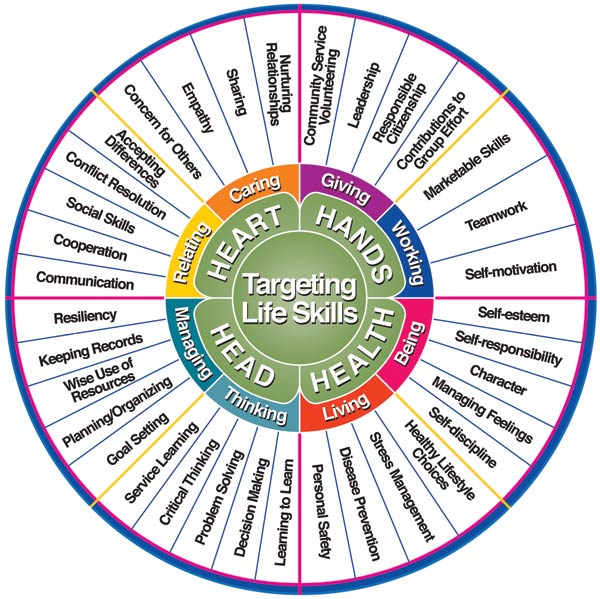Impact 4-H Makes
Key to the 4-H Program is the development of life skills that help participants lead productive and satisfying lives. The program focuses on fostering skills that are healthy and productive for both youth and their communities. Helping youth meet their basic needs and acquire the competencies important to their immediate and future success is the role of the youth development professional.
In a recent survey, 4-H members in their last year of participation were asked to rate the influence that Indiana 4-H had on their development of 35 important life skills. Sometimes referred to as "soft skills," these are the skills that researchers believe help to bridge academic achievement with post-secondary and workplace experiences, thus enhancing an individual's chances of moving successfully into adulthood.
The Targeting Life Skills Model
The life skills assessed by survey respondents came from the Targeting Life Skills Model developed by Patricia Hendricks of the Iowa 4-H Program. With this model, skills that are needed for the positive growth and development of a young person are aligned with the four components of the 4-H pledge: head, heart, hands, and health. The model is utilized by 4-H professionals and volunteers as a framework to organize the delivery of 4-H experiences that teach the life skills identified in the model.

Head: Knowledge, Reasoning, and Creativity Competencies
Thinking: Using one's mind to form ideas and make decisions; to imagine; to examine carefully in the mind; to consider.
Managing: Using resources to accomplish a purpose.
Heart: Personal/Social Competencies
Relating: Establishing a mutual or reciprocal connection between two people that is wholesome and meaningful to both.
Caring: Showing understanding, kindness, concern, and affection for others.
Hands: Vocational/Citizenship Competencies
Giving: Providing, supplying, or causing to happen (social responsibility).
Working: Accomplishing something or earning pay to support oneself through physical or mental effort.
Health: Health/Physical Competencies
Living: Acting or behaving; the manner or style of daily life.
Being: Living one's life; pursuing one's basic nature; involved in personal development.
Key Findings
Survey respondents rated how their participation in 4-H influenced the development of the 35 life skills in the model using a scale of 1 to 5.
References
Hendricks, P.A. Developing Youth Curriculum Using the Targeting Life Skills Model: Incorporating Developmentally Appropriate Learning Opportunities to Assess Impact of Life Skill Development (Iowa State Extension Publication 4H-137A, 1998). Ames, IA: Iowa State University.
Mosier, T.M. "Assessment of Perceived Life Skill Development of Indiana 4-H Members." Master's thesis, Purdue University, 2008. http://docs.lib.purdue.edu/dissertations/AAI1469723/
Results reported based on work by Tyler Wilson, Graduate Student, Purdue University Department of Youth Development & Agricultural Education and Renee K. McKee, Ph.D., Purdue Extension Program Leader, 4-H Youth Development
